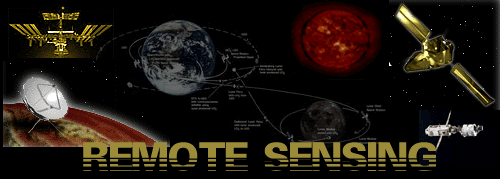What is Remote Sensing?
Satellites are "remote sensor" that collect information about the planet without physically contacting it. Everyday examples of remote sensors include our eyes and cameras. A satellite sensor works like our eyes do, with a few important exceptions. Our eyes only collect images in the visible portion of the electromagnetic spectrum (EM spectrum) whereas satellite sensors can collect images from all over the EM spectrum. Individual sensors collect images at specific regions of the EM spectrum called channels; the channel used depends on the information desired. For example, to collect primary productivity (plant photosynthesis) data, the sensor would use the channels within the visible and infrared. For sea surface height data, microwave channels are used. When EM radiation (light) hits the surface of an object, different wavelengths are either reflected or absorbed depending on the physical and chemical properties of the object. The EM radiation that reflects off the object and returns to the sensor is said to have a particular spectral signature. For example, phytoplankton (tiny plant-like organisms in the ocean) reflect mostly green light and absorb blue and red light (like leaves on trees). Therefore, even though we often can't see phytoplankton with the naked eye, we can use satellites to map areas of high productivity (lots of phytoplankton).
Disadvantages of Satellite Sensors
* Satellite sensors can only "see" the surface of the water. We can only surmise what is going on below.
* Only a small percentage of the original light remains after the long journey from the sun, through the atmosphere, into the ocean, and back up to the sensor. This means our satellite instruments and the equations we use to understand sensor information must be precise so we don't misinterpret the information.
* To correctly interpret data from satellite sensors, we must compare these data to "ground-truth" data. For instance, before phytoplankton pigment concentration can be derived from SeaWiFS data, we first have to measure how EM radiation changes as it interacts with bodies of water with known quantities of phytoplankton pigment. Then we can develop models that tell us how to interpret the signals we get from satellite sensors.
The Electromagnetic Spectrum
Gamma rays, microwaves, and radar are terms we use to divide the continuous spectrum of radiation (light) transmitted by the sun. The spectrums runs from high energy, short wavelength (gamma rays and x-rays) to low energy, long wavelength (TV and radio waves); visible light, the only part of the spectrum that humans can see, falls roughly in the middle of these extremes. Each different region of the spectrum has unique properties and uses. The following is a list of the various regions and some common remote-sensing applications:
- Gamma rays and X-rays: Completely absorbed by the upper atmosphere; not available for satellite remote sensing
- Ultraviolet: Ozone layer studies
- Visible: Estimating ocean primary productivity, monitoring red tide, ocean circulation studies
- Infrared: Determining atmospheric and sea-surface temperaturesMicrowave: Determining sea-surface height, sea ice studies
- Radio: Terrain mapping, hurricane tracking
Available Satellites and What They Measure
• TOPEX/Poseidon—The radar altimeter aboard the TOPEX/Poseidon satellite measures sea surface height with an accuracy of 5cm or better. That’s pretty amazing for an instrument that orbits the earth 1,330 km above the earth. (Measures microwaves; http://topex-www.jpl.nasa.gov)• Advanced Very High Resolution Radiometer (AVHRR)—The AVHRR sensor, which is deployed on the National Oceanic and Atmospheric Administration’s (NOAA) polar-orbiting satellite, is used primarily for temperature measurements involved in studying ice and snow cover, sea-surface temperature, forest fires, and hurricanes. (Measures visible, near infrared and thermal infrared wavelengths; http://edcdaac.usgs.gov/1KM/avhrr.sensor.html)
• Coastal Zone Color Scanner (CZCS) & Sea Viewing Wide Field Sensor (SeaWiFS)— SeaWiFS and CZCS are both “Ocean Color” sensors that can detect tiny differences in ocean color and are far more sensitive than the human eye. SeaWiFS, launched in 1997, is a follow-up to CZCS, which collected data from 1978 to 1986. Ocean color data are used to determine the concentration of phytoplankton and other materials in the ocean so we can better understand things like primary productivity of the ocean and pollution. Phytoplankton blooms can easily be detected and tracked using this satellite. (Measures visible wavelengths; http://seawifs.gsfc.nasa.gov)
• Synthetic Aperture Radar (SAR)—SAR is basically a radio antenna in space that emits very rapid pulses of energy and measures how strongly the waves are scattered back. It is considered an “active” remote sensor because it emits its own source of EM radiation. SAR, which can “see” through clouds and can collect data day or night, is useful for monitoring glaciers and sea ice, ocean waves, coastal erosion, and disasters such as fires, floods, volcanic eruptions, and oil spills. (Measures radio waves; http://www.asf.alaska.edu)
• Landsat—Landsat is a series of satellites starting with the first Landsat in 1972 to Landsat 7 launched in August of 1999. As the name implies, Landsat was originally designed for terrestrial uses. However, oceanographers have found it useful in coastal and sea-ice studies. (Measures visible and infrared channels; http://landsat7.usgs.gov)
